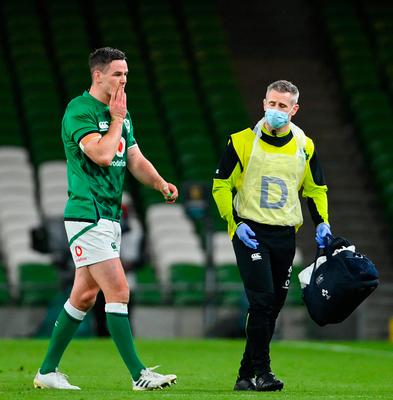
Dr James Thing
Specialist expertise: Sports Injuries, Sports Medicine, Sports and Exercise Medicine, Orthopaedics, Carpal Tunnel, Trigger Finger, Frozen Shoulder, Tennis Elbow, Musculoskeletal Pain Medicine, Paediatrics.
On a typical Sunday morning the back-pages will be filled with the latest high profile players who have been added to the injury list. One of the most common culprits in elite sport is the hamstring strain or tear. England and Liverpool’s Andy Robertson and Ireland rugby’s Johnny Sexton are just two of the latest elite added to the list last weekend. Hamstring injuries are commonly seen in active patients, so what is the best treatment plan? Dr James Thing, Sports Medicine Consultant at OneWelbeck Orthopaedics, takes a closer look at the varieties of hamstring injuries and what recovery looks like.

The acute muscle injury, a “pulled” hamstring, usually results in a sudden popping or snapping sensation, often associated with an inability to continue playing or running. Readers might recall Derek Redmond at the 1992 Barcelona Olympics, hobbling the final part of his 400m semi-final following a hamstring tear.
Hamstring injury is sometimes associated with bruising and swelling into the back of the thigh and knee, indicating a more serious muscle tear injury. Pain is felt either high up in the buttock at the sitting bone, in the middle of the hamstring muscle, or lower down at the attachment just below the back of the knee.
In teenagers and younger individuals it is also important to consider the possibility that the mature muscle and tendon may have pulled off or ‘avulsed’ a fragment of immature bone at the high hamstring which requires more rapid assessment and early investigation. Sitting bone pain in a young person following a sudden hamstring injury therefore warrants an early medical assessment, i.e. within the first few days to a week.
A twinge that results in an ability to continue play, with little discomfort afterwards and relatively normal walking gait, most likely indicates a minimal injury that can be treated very effectively with early rest and crutches as required. Icing can be effective for pain relief in the early stages and pain killers such as paracetamol may be used.
There is ongoing debate about whether to use anti-inflammatory drugs, i.e. ibuprofen in the early stages of a sudden-onset muscle injury. Current consensus would be to avoid for the first 24 to 48 hours and then to use as required.
As pain settles one can cautiously return to activity, starting with low impact exercise such a static bike cycling, deep water walking and swimming. If this is well tolerated then progression to activity via a run-walk program, where the individual walks for a short period and then intermittently adds in a light jog as pain allows. If this is well tolerated then one can progress to increase the running speed and reducing the walking duration over several days/weeks.
At this stage the individual can gradually reintroduce sport-specific activity, i.e. passing drills and adding in higher speed/sprinting as pain allows. Ideally a physiotherapist can help guide return to play and assist with hamstring strengthening to prevent further injury in the future.
If there is significant bruising/swelling, high hamstring pain or sitting pain in an adolescent or if pain persists despite appropriate early rehabilitation advice with a physiotherapist then it would be beneficial to seek the advice of a Sports Doctor (Sport and Exercise Medicine consultant) who can make a full assessment, discuss likely injury severity and the need for early imaging and ongoing management.
Dr James Thing is a Consultant in Sports and Musculoskeletal Medicine at OneWelbeck Orthopaedics. He is an expert in the treatment of upper limb injury – including frozen shoulder, impingement, tennis elbow and osteoarthritis – as well as the treatment of lower limb tendon disorders such as Achilles, Patellar and ankle tendons and plantar fascia. To schedule a consultation with James, please call +44 (0)203 653 2002 or email bookings.orthopaedics@OneWelbeck.com.
Here at OneWelbeck, we have a team of gastroenterology specialists, state of the art facilities and diagnostics, and highly competitive financial packages for self-funding patients as well as those with private health care.
OrthopaedicsDr. James Thing is a Consultant in Sports and Musculoskeletal Medicine at OneWelbeck Orthopaedics. His clinical interests are in hand and wrist injury including treatment of trigger finger, tendon injury, osteoarthritis, ligament injury, carpal tunnel syndrome.